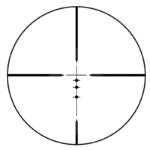 Bullet Drop Compensation rifle scopes, or more commonly referred to simply as BDC scopes, lead to more questions than answers for most of us. Questions stemming from using BDC scopes may also apply to MIL-DOT scopes as well. Factually speaking, these questions put us in the middle of the cross-hairs when using these scopes. What I hope to achieve in this article; albeit long, is to remove some of the mystery surrounding the use of these scopes, which actually may add more mystery at the same time.
Bullet Drop Compensation rifle scopes, or more commonly referred to simply as BDC scopes, lead to more questions than answers for most of us. Questions stemming from using BDC scopes may also apply to MIL-DOT scopes as well. Factually speaking, these questions put us in the middle of the cross-hairs when using these scopes. What I hope to achieve in this article; albeit long, is to remove some of the mystery surrounding the use of these scopes, which actually may add more mystery at the same time.
Not too long ago, rifle scope simply consisted of a plain and simple reticle that resembled two lines, horizontal and vertical, which crossed in the middle to provide us with a focal point to which we used to place on a target some point distant. This still applies today for many magnified optics (and some not magnified), but has given way to more sophisticated sighting devices with the BDC scope being one of them. We happily jumped into the BDC scope arena and soon realized that we had to figure out just what this thing was because many manufacturers simply did not fully explain the factors involved with using such sighting devices. That left many shooters to simply disregard the BDC units (hash marks, circles, or dots) and continue on in the way we normally continue on – obliviously. We were left to our own amazement, after taking a two-hundred yard, or three-hundred at fifty yard shot with a rifle zeroed at one-hundred yards, by raising the scope (and subsequently the muzzle of the rifle until a hash mark, circle, or dot was centered on the target, and then seeing the bullet miss the target completely. Obviously, the scope has to be at fault. No, it was not the scope’s fault, but it was the fault of the user for not understanding what he (or she) was viewing right in front of their eye – literally. So, let’s get into the reality of using a BDC scope.
Before continuing on, I need to state that this article is targeted (no pun intended) for the average shooter, like myself, who simply needs to understand what BDC actually is and how we can use it to better our shooting. Those who are running ballistic support devices (BORS, SAM, or CCD/LCD) are free from the challenge that we everyday shooters face when target shooting (pleasure or sport), hunting, or defending against enemies at the gate.
First, let’s view a description of Bullet Drop Compensation provided by https://en.wikipedia.org/wiki/Telescopic_sight#Bullet_Drop_Compensation, and then dive into some of the important points of the description:
Bullet Drop Compensation (BDC) (sometimes referred to as ballistic elevation) is a feature available on some rifle scopes. The feature compensates for the effect of gravity on the bullet at given distances (referred to as “bullet drop”) in flat fire scenarios. The feature must be tuned for the particular ballistic trajectory of a particular combination of gun and cartridge at a predefined muzzle velocity and air density. Telescopic sights designed for military use like the ACOG or PSO-1 featuring BDC reticles or elevation turrets with range markings are fairly common, though commercial manufacturers offer the option to install a BDC reticle or elevation turret as long as the customer supplies the necessary ballistic data. Since the usage of standardized ammunition is an important prerequisite to match the BDC feature to the external ballistic behavior of the employed projectiles, telescopic sights with BDC are generally intended to assist with field shooting at targets at varying medium to longer ranges rather than precise long range shots. With increasing range inevitable BDC induced errors will occur when the environmental and meteorological circumstances deviate from the predefined circumstances for which the BDC was calibrated. Marksmen can be trained to understand the main forces acting on the projectile and their effect on their particular gun and ammunition and the effects of external factors at longer ranges to counter these errors.
Let’s look at the following statement that was extracted from the previous description:
…telescopic sights with BDC are generally intended to assist with field shooting at targets at varying medium to longer ranges rather than precise long range shots.
What should be added to this statement is that “varying medium to longer ranges” means distances greater than the established zero of the firearm/ammunition combination. Any reference to ballistics prior to the zero distance is essentially disregarded, although ballistic characteristics certainly are a factor. It should be important to note that a horizontal effect on a projectile’s path is also disregarded; we are simply talking “bullet drop” and not “bullet drift” that, agreeably, can affect the POI of a projectile in relation to our POA. In short, the project’s flight path before the zero point is far less important than what happens to that projectile further down-rage from the zero point.
Also a truism with the article from Wikipedia is the fact that a shooter can have a scope tailored to his or her exact rifle/ammunition specifications; all it takes is money, really. For the majority of us, we are subject to whatever COTS BDC scope that we have mounted on our favorite rifle. With that said, let’s get to the heart of this BDC issue.
We can extract the following from the Wikipedia quote; “The feature must be tuned for the particular ballistic trajectory of a particular combination of gun and cartridge at a predefined muzzle velocity and air density.” Well, for the majority of us, “tailoring” the BDC feature is not an option. In our case, the following statement applies; “The feature must be defined for the particular ballistic trajectory of a particular combination of gun and cartridge at a predefined muzzle velocity and air density.” The term “Tuned” and “Defined” are entirely different in their context.
To continue this discussion, please assume that nothing is exact, everything is variable, and all things are relative. No ambiguity there, right?
Also to continue this discussion, I will have to establish some assumptions that, of course could be questioned, but I have a reason for establishing these assumption, and which I will get to later in the article.
The rifle for my first example is a very common Remington Model 700 chambered in .308 Winchester. The scope that I have selected for this journey is the Nikon BUCKMASTERS II 3-9x40MM with BDC reticle. You might question the scope of choice, but let me continue with the fact that Nikon has been the only scope manufacturer that provides the most data regarding their line of BDC magnified optics. I have tried obtaining specific BDC information from Bushnell and Leupold without any success – so Nikon it is. A second reason is that the Nikon SpotOn application was a great source of images for this article.
The scope is mounted so that the center-line of the scope is 1.5 inches above the bore axis of the barrel, and which is a very common setup (scope height is addressed later in the article). Note that I am using default environmental values provided by Nikon, which may not agree with actual shooting conditions.
For ammunition, I am using the Remington 165-grain Pointed Soft Point Core-Lokt @ 2700fps cartridge that has been zeroed at a distance of one-hundred yards. Thanks to Nikon, I have some ballistics data on this cartridge, and this data is shown in the chart that follows.

Author’s Note: You will notice two columns in the ballistic table titled “PATH” and “DROP.” To the uninitiated, these two terms are confusing. The following provides an explanation for each term:
- Drop is the actual drop of the bullet if the barrel is level with the ground, and not taking into account the line of sight. Drop does not take into account the sight height.
- Path is the drop of the bullet based on a zero range that is past the barrel. Path takes into account sight height.
- Since a bullet begins to drop as soon as it leaves the muzzle, you must elevate the barrel to hit targets further than point blank range.
- Path shows that the bullet must rise slightly in order to meet your line of sight in order to hit these targets (zero) and then begins to drop past the initial zero.
One thing that you might notice about the above chart is the ZERO ADJ (Clicks) column. I’ll get to that in due time.
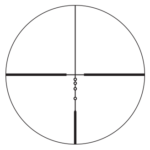
Nikon BDC Reticle
The Nikon BUCKMASTERS II 3-9x40MM scope has a reticle picture that looks like that shown in the accompanying image. Each circle below the cross-hair represents a bullet drop point past the zero distance. But, what measurement of drop do they represent? More importantly, what distance does each circle represent? Using an application from Nikon, we can find out. But, before we get to that point, let’s consider something.
Would it not be great if each circle represented an equal distance beyond our zero distance? For example, the first circle would be one-hundred and twenty-five yards; the second circle would be one-hundred and fifty yards, and so on. In reality, it does not work that way. A projectile does not fall an equal distance within equal distance; it is very non-linear in fashion. Once a projectile is “played out” by the effects of the environment, it can drop very rapidly.
The application provided by Nikon takes in consideration all factors that affect the projectile and calculates where the projectile is according to the BDC marks.
The following is a breakdown of the BDC points according to the data that was dialed in (or calculated) for atmospheric conditions. For the sake of this discussion, I simply accepted the default data.
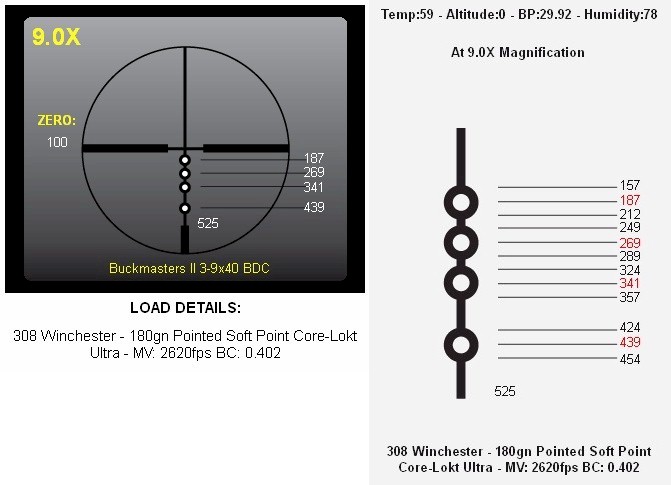
To break the increments down further, more detail is provided on the right side of the image:
We can see from the first BDC point that there are actually three distances covered; a plus and minus to the center, it could be said. The first BDC point would then be; 224 -25/+22 yards. The first BDC point provides us with a reference of 199 yards to 246 yards, depending on what part of the BDC point is used. Within those forty-seven yards, the projectile is going to drop roughly 4-inches. Now where, you might ask, did I get that information? Well, I had to go back to the ballistic chart for that cartridge and roughly guesstimate the drop between two-hundred yards and two-hundred and forty yards; I felt that 4-inches would be a nominal value to use.
Depending on the size of the target, and the point of aim on the target, the POI could be a kill shot, a wounding shot, a hit, or a miss shot. I would like to be more accurate than that, but without knowing all of the factors involved in the shot, a more accurate answer is not going to be possible.
Now, there are some other things to consider regarding Nikon scopes with BDC, per Nikon;
All Nikon riflescopes (and most other manufacturers’ scopes) are designed with reticles in the second optical focal plane. This means that when you change the magnification, the reticle changes in proportion to the target.
That being said, since the crosshair is located in the optical center of the scope, it does not change point of impact with magnification changes.
If you look through the scope at a target and vary the magnification, you will see the position of the BDC circles changes in relation to the target. This is the reason the BDC reticle was originally designed to be used on the highest power.
I address the magnification issue later in the article. For now; however, let’s take a look at what affect changing from one cartridge to another has on BDC.
AMMUNITION DEPENDENCY:
Having established relative BDC values for one cartridge, what happens if I change ammunition? In the previous example, I established BDC values for the Remington 165-grain Pointed Soft Point Core-Lokt @ 2700fps. Now, I want to shoot 180-grain Pointed Soft Point Core-Lock Ultra @ 2620fps. How is my BDC affected by this change? Well, and according to Nikon, here are the BDC values for the 180-grain Pointed Soft Point Core-Lock Ultra @ 2620fps:

In this case, there is only about two yards difference between Remington 165-grain Pointed Soft Point Core-Lokt @ 2700fps and 180-grain Pointed Soft Point Core-Lock Ultra @ 2620fps. But, let’s make it interesting.
How about a switch to a 55-grain Soft Point Accelerator @ 3770fps cartridge?
The difference in BDC values is substantial as observed below.
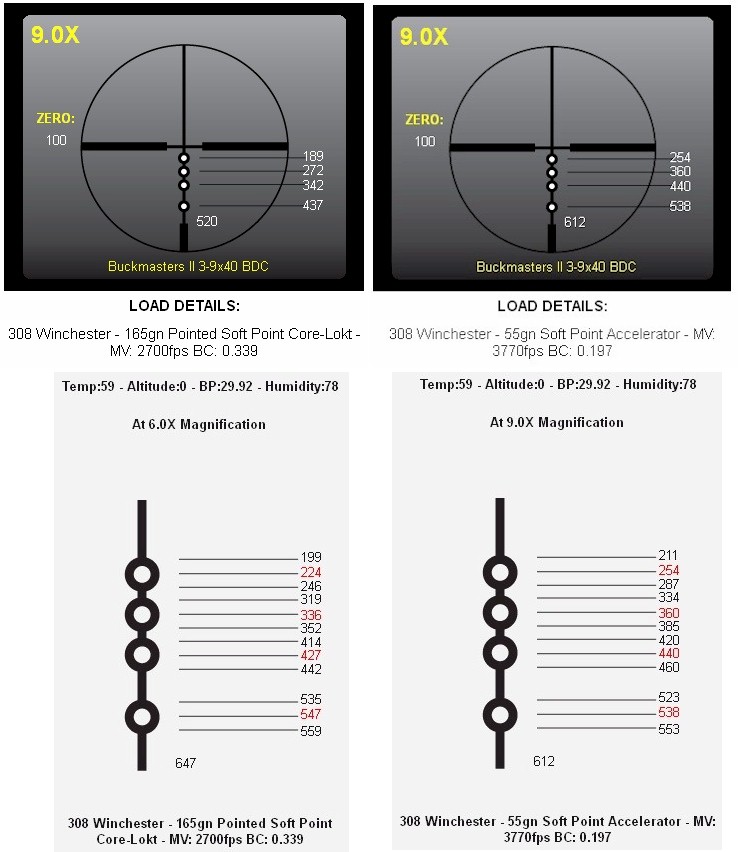
What is more interesting is the ballistic data for the cartridge:

Now, let’s go to a second example to see how things play out.
I have a 4-12×40 Nikon PROSTAFF Rimfire II scope sitting atop of a Ruger American Rimfire 22LR rifle. I am shooting Federal AM22 40-grain @ 1200fps. I have zeroed this rifle at twenty-five yards for some friendly competition with a shooting companion. But, what if I decided to use this rifle for shooting at a target set at a further distance than my zero point. How accurate would the BDC marks be in relation to the distance of my target?
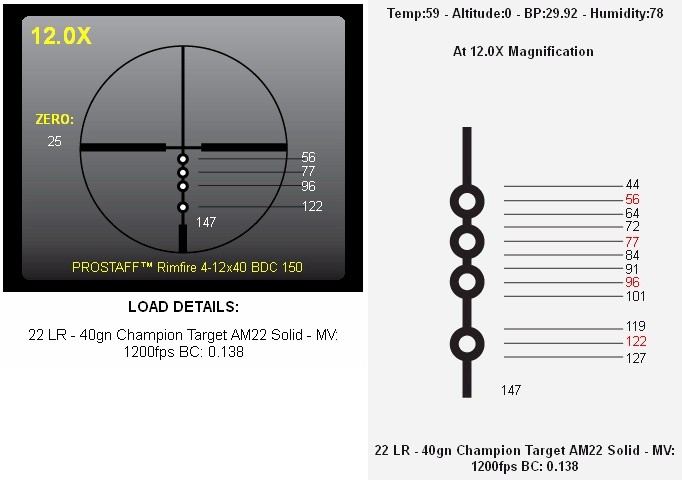

I think that you can see by now this BDC stuff can be quite complicated and not as simple as just shifting the scope’s sight picture according to BDC points. To put it quite bluntly, BDC scopes are relatively useless for precision shots at distances beyond the zero point of the scope/rifle combination. Referring back to the original quote from Wikipedia; “With increasing range inevitable BDC induced errors will occur when the environmental and meteorological circumstances deviate from the predefined circumstances for which the BDC was calibrated.”
And, now for another dose of reality; the same applies to any MOA or MIL-DOT scope that is not specifically calibrated for the rifle/ballistic combination, and even then it is still questionable. There are just too many variables at play even before the shot is taken, let alone after the projectile leaves the barrel.
Am I saying that BDC, MOA, or MIL-DOT magnified optics are useless? Of course not! They are; however, limited in scope (no pun intended) and are highly dependent on external factors, and in order to use them to their fullest, the external factors must be identified and understood, regardless of the scope.
One Last Thing Regarding Ammunition:
Most ammunition manufacturers cite ballistic information for their ammunition with a certain barrel length. Because barrel length affects the velocity of a projectile, it would only be fair to say that barrel length also affects BDC values. The velocity figure for the Remington 165-grain Pointed Soft Point Core-Lokt cartridge is 2700fps, and is based on a 24” barrel. Firing this same cartridge from a Remington 700XCR Compact with a 20” barrel, would have an affect on BDC values. To what extent, I can’t say. But, I can say that the BDC values present herein, would be invalid. With that said, chronographing the cartridge to establish a mean muzzle velocity, from your rifle of choice, and then customizing the ballistic data to reflect the muzzle velocity, would result in more realistic BDC values.
Also, here is some information from Remington Arms:
“The degree to which your barrel is shorter or longer will respectively decrease or increase muzzle velocity, and thus require elevation changes, a significant factor since some rifles have 26-inch and even 20-inch barrels.
Also, here is some information from Remington Arms:
The degree to which your barrel is shorter or longer will respectively decrease or increase muzzle velocity, and thus require elevation changes, a significant factor since some rifles have 26-inch and even 20-inch barrels.
Here are the three rules of thumb, as disseminated by Remington Arms Company:
- For cartridges generating a muzzle velocity of 2000 – 2500 fps, each inch a barrel is longer or shorter than 24 inches changes velocity 10 fps;
- For cartridges generating 2500 – 3000 fps, one inch will vary velocity 20 fps;
- High velocity cartridges, generating 3000 – 3500 fps, will change muzzle velocity 30 fps per inch of barrel.
While these velocity differences seem minimal – at 100 yards there’s almost no noticeable change in trajectory – the effect becomes significant at long range. For example, the .308, 168-gr. BTHP Match round will impact six inches lower at 500 yards when fired from a 20-inch barrel, then when fired from a 24-inch barrel.
After determining your round’s muzzle velocity for your barrel length, consult a good ballistic software program to chart how it changes the bullet’s trajectory.
MAGNIFICATION EFFECTS:
For this part, I am going to refer to the statement from Nikon that was used previously;
“All Nikon riflescopes (and most other manufacturers’ scopes) are designed with reticles in the second optical focal plane. This means that when you change the magnification, the reticle changes in proportion to the target.
That being said, since the crosshair is located in the optical center of the scope, it does not change point of impact with magnification changes.
If you look through the scope at a target and vary the magnification, you will see the position of the BDC circles changes in relation to the target. This is the reason the BDC reticle was originally designed to be used on the highest power.
What can be observed in above example is just how much difference there is in BDC values with a simple 2X magnification change.
If you will indulge me for a bit, I would like to return to my current scope setup with the Ruger American Rimfire 22LR rifle.
As I mentioned, the rifle is zeroed at twenty-five yards for friendly competition purposes. But, what if I needed to take a shot at one-hundred yards with this setup? What do I need to do?
The scope is set at 6X at twenty-five yards, which for my old eyes, is a good setting. For a one-hundred yard shot, I could leave the magnification at 6X and use the BDC marks to adjust my POI. For a one-hundred yard shot, I would need to be somewhere in the center between the first and second BDC points, as shown in the accompanying image. However, I would need more magnification with a target at one-hundred yards. I would probably have the propensity to take all I could and crank the scope magnification to its limit of 12X. With that level of magnification, I could clearly see my intended POI. However, in making that change in magnification, I also change the BDC values, as shown in the accompanying image.
As shown in the image that follows, at a maximum magnification of 12X, the third BDC mark would be my guiding light for a one-hundred yard shot.
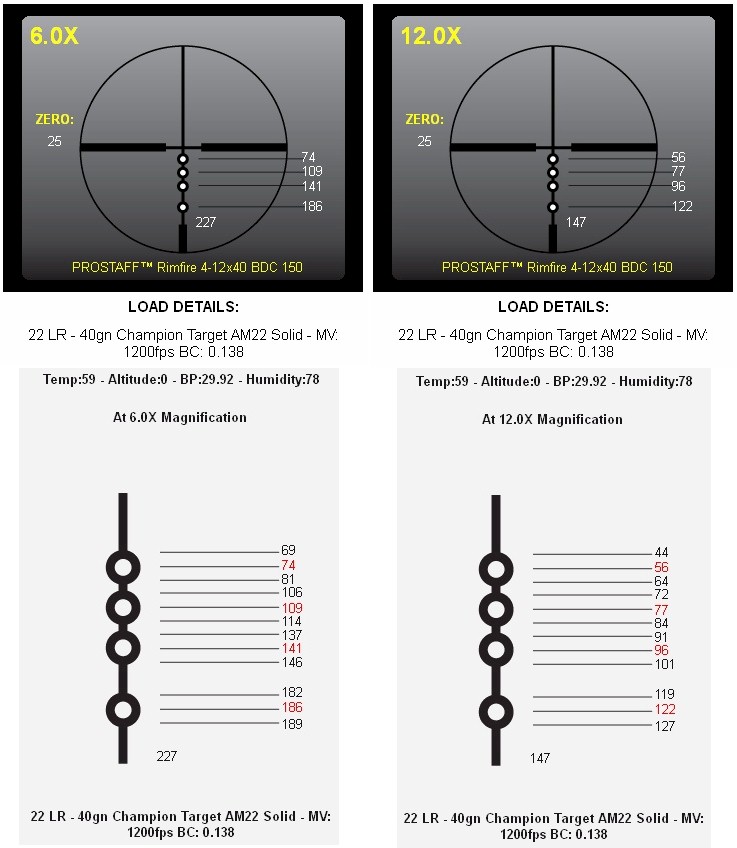
DISTANCE EFFECTS – KNOWN vs. UNKNOWN
Once we settle in on a scope, the first order of business is to zero the scope/firearm at a known distance. A common zero distance, with possible exception of small-bore firearms, is one-hundred yards. Of course, there are exceptions to the one-hundred yard zero, but in just keeping the discussion simple I’ll just stick to a one-hundred yard zero.
For the sake of simplicity, I am going to fall back to the Remington 700 in .308 Winchester under the Nikon BUCKMASTERS II 3-9x40MM with BDC reticle scope with a center-line 1.5 inches above the centerline line of the bore.
For ammunition, I will be using the same ammunition that I started out with; the Remington 165-grain Pointed Soft Point Core-Lokt @ 2700fps cartridge that has been zeroed at a distance of one-hundred yards. Thanks to Nikon, I have some ballistics data on this cartridge, and this data is shown in the chart that follows.

The BDC information at maximum magnification is shown below.
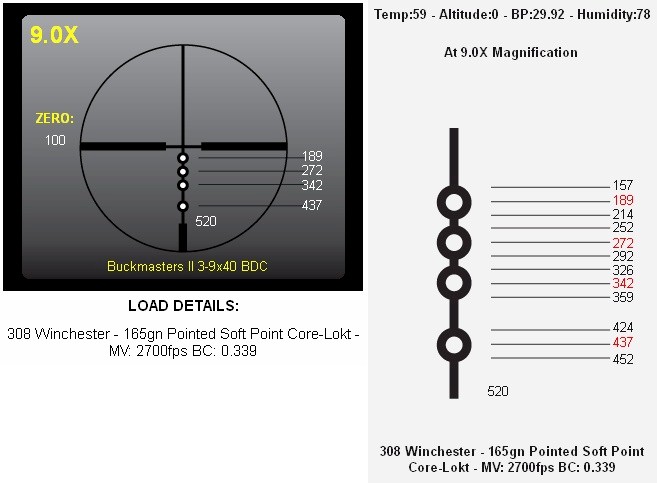
We can see that, at full magnification, and to make a two-hundred yard shot, I could hold center on the target with the first BDC mark set between the center and bottom of the BDC mark. But, can I make that a little better? Below is the example for dropping the magnification to 8X.
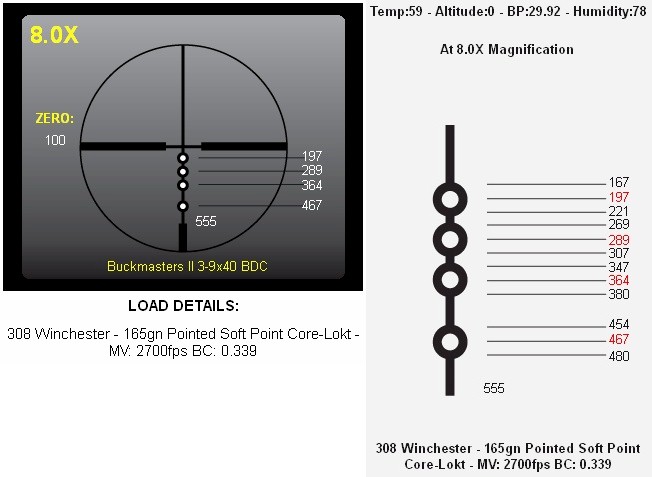
By dropping one level of magnification, I could probably place the center of the first BDC mark on the desired POI to garner a more accurate shot. One level of magnification is really not going to affect my scope sight picture to a great extent.
Of course, all of this is great to know at known target distances. The reality is that in the field, targets are not at known distances – until they are. To tell the truth, I am not skilled in judging distances – especially if I don’t have a known reference point. This is where I rely on a device called a rangefinder, or rely on someone who has one of these devices and can feed me the information that I need to take the shot. So, here is where it gets interesting, because it is up to me to make the applicable adjustments for the shot.
Let’s say, for the sake of discussion, that my “Spotter” tells me that my target is 237-yards distant. My rifle/scope combination is set up for a 100-yard zero. With maximum magnification, and current 100-yard zero, my BDC values look like that on the left of the following image.
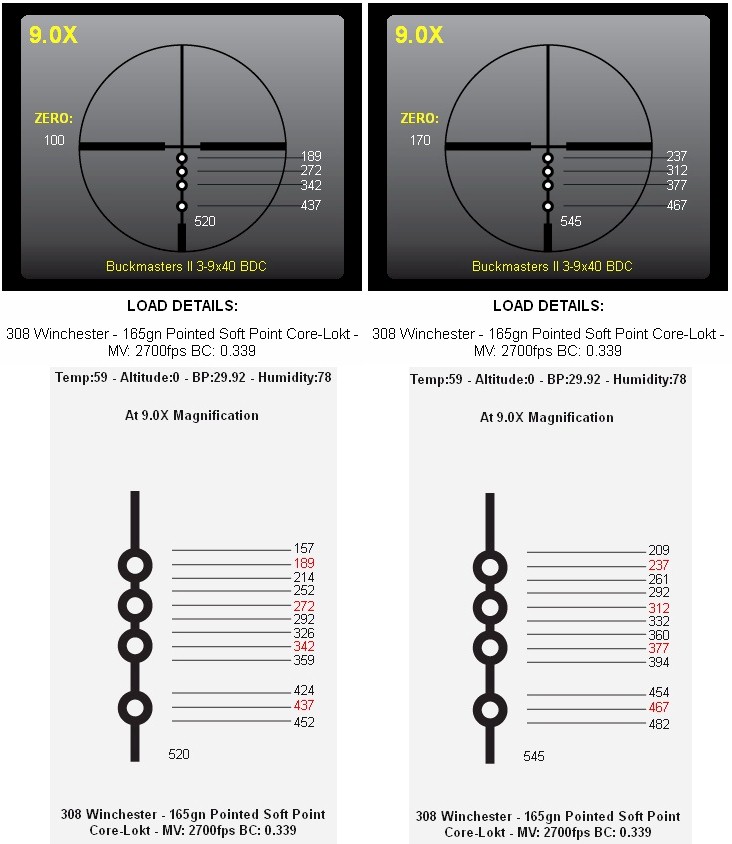
With my current setup, it would be extremely difficult (for me) to obtain an accurate shot given the BDC values. I actually have a way to make a difficult shot easier. For this shot, I am going to change my zero. Remember my mention of “clicks” early in this article?
WORKING THE ANGLES:
This far, I have been discussing level shooting where the target is on the same plane as the shooting position. Angular shooting, where the target is above or below you, may require a change in elevation, which as we know, affects the BDC.
When your target is uphill or downhill, your round will impact high if you aim dead-on. (The explanation is complex and worthy of a future article, but for now, just trust me.) There are several methods to determine the amount of compensation, but the quickest involves these simple Rules of Thumb:
- For a target 45 degrees up or down, multiply the actual distance by 0.7, set your scope elevation for this distance and aim dead-on;
- When the target’s 30 degrees up or down, multiply its range by 0.9, set your scope for this distance and aim dead-on;
- If the target angle is less than 30 degrees, aim dead-on.
HAPPINESS IS JUST A CLICK AWAY!
 It makes sense to say that, knowing what we know thus far, changing our zero will affect BDC values. But to what zero do I change to? It would seem that a 200-yard zero would be the answer. Then, I would only need a hair of holdover to hit a target 235 yards distant. If you can tell me what a “hair” is at that distance, I am all ears. What is needed is that I adjust my zero so that my BDC values will be as close to the distance of my target as possible – without splitting hairs. In this case, setting zero to 170 yards works out well. So, how to I get a zero at 170 yards? I dial it in by adjusting my elevation turret! According to the ballistics information for the cartridge, I need 5 clicks of “up” elevation, from my current setting, to obtain a 170-yard zero. At a 170-yard zero, the BDC values change to that in the right side of the referenced image. With this setting, I could place the first BDC circle on the target at 235 yards and increase my chances of actually hitting it. To change my zero at this point, I can simply dial-in or dial-out clicks of elevation; to return to my 100-yards zero, I “dial-out” 5 clicks. To change my zero to 250-yards, I can simply “dial-in” and additional 9 clicks. From that point, I can return to my 100-yard zero by “dialing-out” 14 clicks.
It makes sense to say that, knowing what we know thus far, changing our zero will affect BDC values. But to what zero do I change to? It would seem that a 200-yard zero would be the answer. Then, I would only need a hair of holdover to hit a target 235 yards distant. If you can tell me what a “hair” is at that distance, I am all ears. What is needed is that I adjust my zero so that my BDC values will be as close to the distance of my target as possible – without splitting hairs. In this case, setting zero to 170 yards works out well. So, how to I get a zero at 170 yards? I dial it in by adjusting my elevation turret! According to the ballistics information for the cartridge, I need 5 clicks of “up” elevation, from my current setting, to obtain a 170-yard zero. At a 170-yard zero, the BDC values change to that in the right side of the referenced image. With this setting, I could place the first BDC circle on the target at 235 yards and increase my chances of actually hitting it. To change my zero at this point, I can simply dial-in or dial-out clicks of elevation; to return to my 100-yards zero, I “dial-out” 5 clicks. To change my zero to 250-yards, I can simply “dial-in” and additional 9 clicks. From that point, I can return to my 100-yard zero by “dialing-out” 14 clicks.
Hitting targets at extreme distances takes extreme marksmanship, a thorough knowledge of the equipment being used, and the limits of their use. There have been shots taken that exceed the limits of the scope being used, but it takes a highly-skilled marksman (or woman) to pull those shots off and hit the intended target. For the scope used in this example, the Nikon BUCKMASTERS II 3-9x40MM with BDC reticle, it would seem that a 1000 yard zero is the upper limit of the scope, with the highest BDC distance being 1119 yards. My upper limit with this scope is substantially less.
SCOPE MOUNTING AFFECTS:
Just when you thought it was done, I’m going throw this last thing in – scope mounting height.
Throughout the examples used in this article, the scope mounting height was 1.5-inches. What if, for example, you wanted to change your scope mounting height to 2-inches? Does changing the scope mounting height have an appreciable affect on the BDC values of your scope? You bet it does!
The following is an example of my original BDC values with the scope mounted at 1.5” (left) and the BDC values with the scope mounted at 2” (right). The ammunition and zero is the same for both setups.

TO BDC OR NOT BDC – SHOULD THAT BE A QUESTION:
At this point, or even before, you may be questioning the need for a BDC scope. There is no simple answer to that question. What first must be answered is what use you intend for the scope. Regardless if you prefer a different type of reticle (for example, a MIL-DOT), the same question poses an answer. Most scope manufacturers offer different reticle styles. For example, Leupold offers a myriad of reticles and these are shown in the accompanying image.

Leupold and Nikon also offer matched ballistic reticles to which BDC is calibrated to your specific rifle and load.
In the image that follows, the Bushnell Elite Long Range Hunter LRHSi 4.5-18x 44mm (left) offers a quite complex sight image in its design as compared to the Bushnell Banner 3-9×40 hunting scope (right).
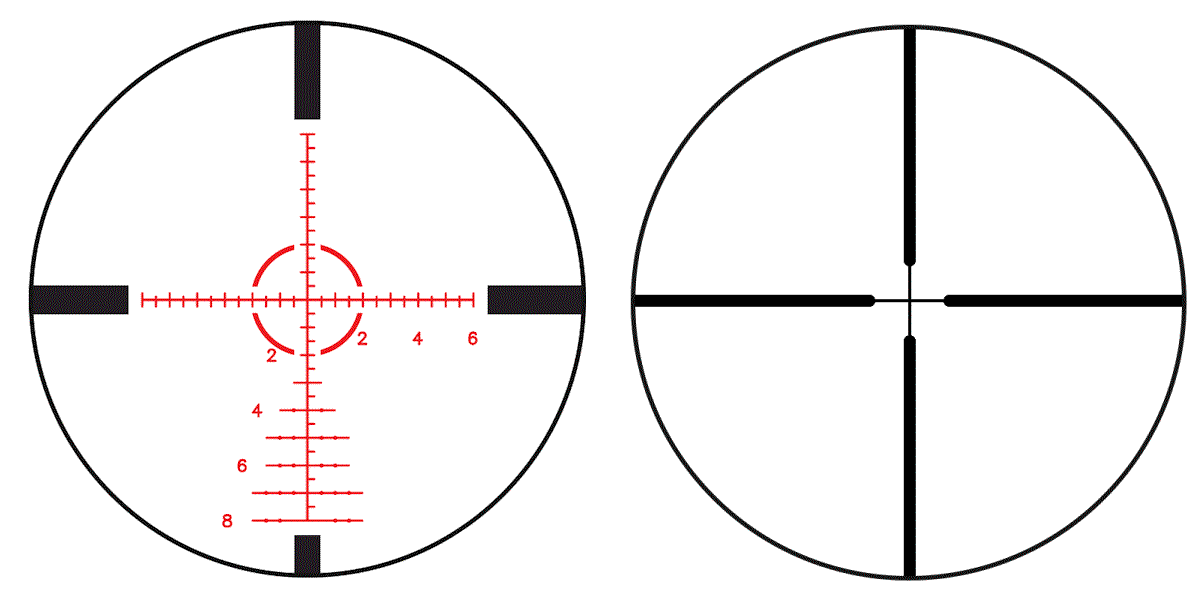
TO SUMMARIZE ALL OF THIS:
BDC, MIL_DOT, and other rifle (and even pistol) magnified optics address the want and/or need in most of us to view some target at some point distant for placing accurate shots on the target. Someone once told me, “Everything is properly useful, but not all things are used properly.” I guess the same could be said for BDC scopes. Unless the shooter understands the pros and cons of these devices, they will not be used to their full potential.
BDC scopes are dependent on…
- The rifle
- The ammunition
- Atmospheric conditions
- Scope Mounting Height
- Scope magnification settings
- Zero settings
- Scope quality
- The human factor
- Distance
While not directly affecting BDC values, we also have possible mirage affects, the curvature of the earth, how many cups of coffee you drank, the effects of a hangover, barrel temperature, etc., that will affect our ability to place shots at our desired POI relative to our POA.
Does a BDC scope have an advantage over a scope with a simple cross-hair? Yes, but only if you are willing to take the time to work with and understand the rifle/scope/ammunition combination. Otherwise, I see no advantage with a BDC scope over a simple reticle scope. Working with and understanding the rifle/scope/ammunition combination means “keeping book” with it.
KEEPING BOOK:
In short, “keeping book” simply means maintaining a “Shooter’s Log” that is used to document the rifle/scope/ammunition combination over time. Whether the “Shooter’s Log” is pre-formatted (http://www.sinclairintl.com/) or one of your own making, maintaining even a simple “Shooter’s Log” can tell you a lot about critical shot data and general information for the current shooting event and also to compare past shooting performances.
I find, even with shooting at close distances, that varying ammunition will have different effects on my shooting performance, and I cannot remember the performance from one load to the next with what pistol or rifle fired that ammunition. Even at my usual twenty-five yard friendly competition distance, swapping from one .22 LR caliber load to another can make a difference in shot placement. Where one load does fine, another will not be so fine in the same firearm, but will excel in a different firearm. If I have documented well, a year from now when I pull a firearm from the safe to shoot, I have a record to help jog the memory cells – if nothing else.
At this point, I will willingly admit that I am not a stringent record-keeper. Most of the time, I grab a firearm, some ammunition, a few targets, and off to the range I go. But, I have started taking quick notes on each shooting session and then transferring those notes to the computer for archiving; a simple Mead spiral notebook serves well for simply jotting down notes and is compact enough to throw in a pocket or range bag.
CLOSING IT OUT:
So, there you have it! I have presented some thing that I have learned, and I hope that you have found useful, in regards to BDC rifle scopes.
You will note that windage has not been discussed at all. I have kept the discussion to elevation only, because windage is an entirely different ball game and a topic for later research and discussion.
One thing that we can take away is that regardless of how expensive, or how a scope is constructed, using the scope is entirely up to the shooter. A scope properly used is properly useful.
RESOURCES:
- Leupold Ballistic Aiming System: https://www.leupold.com/wp-content/uploads/2016/02/Ballistic-Aiming-System-Manual.pdf
- Mathematics For Precision Shooters: http://www.millettsights.com/resources/shooting-tips/mathematics-for-precision-shooters/
- How to Calculate Distances With a Mil Dot Rifle Scope: http://www.wikihow.com/Calculate-Distances-With-a-Mil-Dot-Rifle-Scope
![]()

